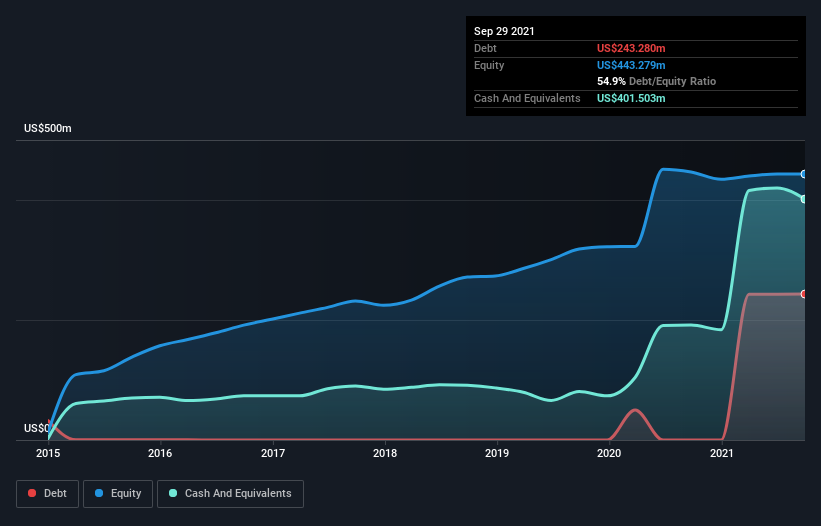Is Shake Shack (NYSE:SHAK) A Risky Investment?
David Iben put it well when he said, 'Volatility is not a risk we care about. What we care about is avoiding the permanent loss of capital.' So it seems the smart money knows that debt - which is usually involved in bankruptcies - is a very important factor, when you assess how risky a company is. As with many other companies Shake Shack Inc. (NYSE:SHAK) makes use of debt. But is this debt a concern to shareholders?
Why Does Debt Bring Risk?
Debt and other liabilities become risky for a business when it cannot easily fulfill those obligations, either with free cash flow or by raising capital at an attractive price. Ultimately, if the company can't fulfill its legal obligations to repay debt, shareholders could walk away with nothing. However, a more frequent (but still costly) occurrence is where a company must issue shares at bargain-basement prices, permanently diluting shareholders, just to shore up its balance sheet. By replacing dilution, though, debt can be an extremely good tool for businesses that need capital to invest in growth at high rates of return. The first thing to do when considering how much debt a business uses is to look at its cash and debt together.
View our latest analysis for Shake Shack
How Much Debt Does Shake Shack Carry?
You can click the graphic below for the historical numbers, but it shows that as of September 2021 Shake Shack had US$243.3m of debt, an increase on none, over one year. But on the other hand it also has US$401.5m in cash, leading to a US$158.2m net cash position.
How Strong Is Shake Shack's Balance Sheet?
Zooming in on the latest balance sheet data, we can see that Shake Shack had liabilities of US$118.3m due within 12 months and liabilities of US$878.8m due beyond that. Offsetting these obligations, it had cash of US$401.5m as well as receivables valued at US$11.3m due within 12 months. So it has liabilities totalling US$584.2m more than its cash and near-term receivables, combined.
Given Shake Shack has a market capitalization of US$3.19b, it's hard to believe these liabilities pose much threat. However, we do think it is worth keeping an eye on its balance sheet strength, as it may change over time. Despite its noteworthy liabilities, Shake Shack boasts net cash, so it's fair to say it does not have a heavy debt load! There's no doubt that we learn most about debt from the balance sheet. But ultimately the future profitability of the business will decide if Shake Shack can strengthen its balance sheet over time. So if you're focused on the future you can check out this free report showing analyst profit forecasts.
In the last year Shake Shack wasn't profitable at an EBIT level, but managed to grow its revenue by 34%, to US$694m. With any luck the company will be able to grow its way to profitability.
So How Risky Is Shake Shack?
By their very nature companies that are losing money are more risky than those with a long history of profitability. And in the last year Shake Shack had an earnings before interest and tax (EBIT) loss, truth be told. And over the same period it saw negative free cash outflow of US$38m and booked a US$18m accounting loss. With only US$158.2m on the balance sheet, it would appear that its going to need to raise capital again soon. With very solid revenue growth in the last year, Shake Shack may be on a path to profitability. Pre-profit companies are often risky, but they can also offer great rewards. When we look at a riskier company, we like to check how their profits (or losses) are trending over time. Today, we're providing readers this interactive graph showing how Shake Shack's profit, revenue, and operating cashflow have changed over the last few years.
At the end of the day, it's often better to focus on companies that are free from net debt. You can access our special list of such companies (all with a track record of profit growth). It's free.
This article by Simply Wall St is general in nature. We provide commentary based on historical data and analyst forecasts only using an unbiased methodology and our articles are not intended to be financial advice. It does not constitute a recommendation to buy or sell any stock, and does not take account of your objectives, or your financial situation. We aim to bring you long-term focused analysis driven by fundamental data. Note that our analysis may not factor in the latest price-sensitive company announcements or qualitative material. Simply Wall St has no position in any stocks mentioned.
Have feedback on this article? Concerned about the content? Get in touch with us directly. Alternatively, email editorial-team (at) simplywallst.com.

